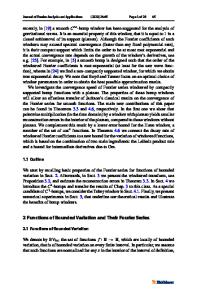Aging resistance and mechanical properties of Sn3.0Ag0.5Cu solder bump joints with different bump shapes
- PDF / 1,325,452 Bytes
- 6 Pages / 595.276 x 790.866 pts Page_size
- 28 Downloads / 335 Views
Rare Met. DOI 10.1007/s12598-015-0612-4
www.editorialmanager.com/rmet
Aging resistance and mechanical properties of Sn3.0Ag0.5Cu solder bump joints with different bump shapes Ping Chen, Xiu-Chen Zhao* Hong Li, Yong Wang
, Ying Liu,
Received: 4 September 2014 / Revised: 22 April 2015 / Accepted: 28 August 2015 Ó The Nonferrous Metals Society of China and Springer-Verlag Berlin Heidelberg 2015
Abstract The effects of bump shape on the aging resistance and mechanical properties of Sn3.0Ag0.5Cu (SAC) solder bump joints were investigated by high-temperature aging test and shear test. Three different SAC solder bump joints with barrel type, cylinder type, and hourglass type, respectively, were provided by controlling solder process. The results indicate that as the bump volume decreases from barrel bump to hourglass bump in the reflow, the thickness growth rate of intermetallic compounds (IMCs) between different solder joints and Cu substrates in the isothermal aging of 150 °C decreases. And the change of shear strength of hourglass interconnection solder joint with the increase in temperature is the minimum in the three interconnection solder joints. Thus, as the solder dosage decreases properly, hourglass interconnection solder joint is obtained, which is avail to enhance the solder joint reliability at the high-temperature aging and the ability to adapt to the change of environment temperature suddenly. Keywords Bump shape; Lead-free solder; Intermetallic compounds; Mechanical properties
P. Chen, X.-C. Zhao*, Y. Liu, H. Li, Y. Wang School of Materials Science and Engineering, Beijing Institute of Technology, Beijing 100081, China e-mail: [email protected] Y. Wang Center of Packaging and Testing, Beijing Microelectronics Technology Institute, Beijing 100076, China
1 Introduction Over the past several decades, the area array packages have been one of the most promising electronic packaging technologies because of many special advantages, such as the low-cost, high-density input/output (I/O), and highperformance interconnection [1–3]. These area array packages require the formation of solder joints for the chip and board surfaces. The solder joints serve as electrical and thermal paths as well as structural supports, which leads to serious reliability issues. The European Union directive on waste electrical and electronic equipment (WEEE) announced the prohibition of the use of lead in the consumer electronics market after January 2006. Recently, many different solder alloys have been proposed as potential replacements for lead-free solder. Among several candidate alloys, the Sn–Ag–Cu solder family is believed to be the most promising substitute for lead-containing solders because of its relatively low melting temperature, its superior mechanical properties, and its relatively good wettability [4–6]. However, many performances of the lead-free solder bump joints is reported to be inferior due to its higher melting temperature than that of Sn and is relatively active with metallization [7, 8]. Therefore, the r
Data Loading...











